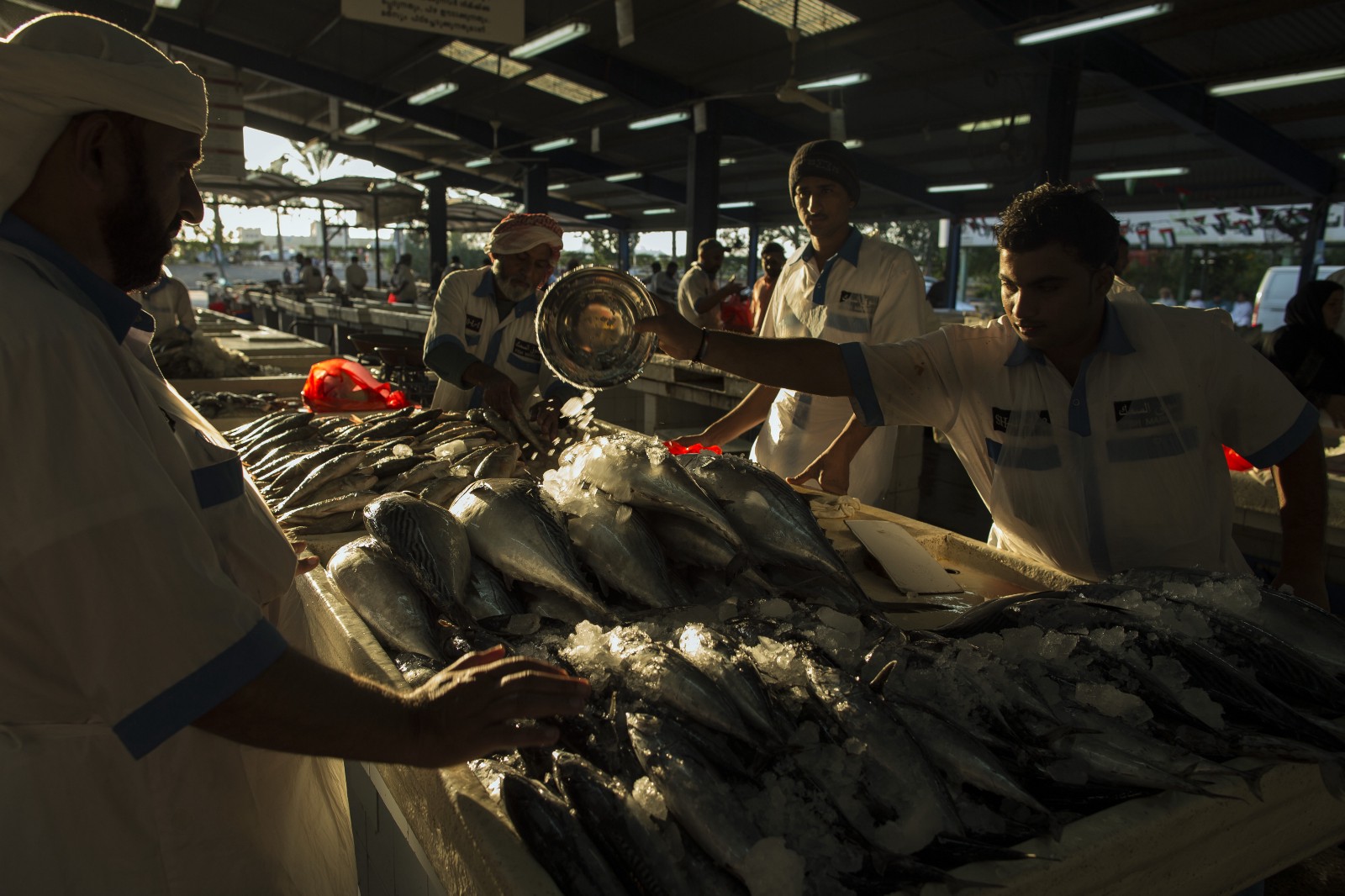A tour through my favorite fish markets in the world, which have taught me more about the economics and spirit of a city than any guidebook ever could.
By Naomi Tomky
The Noryangjin fish market in Seoul, South Korea, on February 3, 2016. (Photo: Ed Jones/AFP/Getty Images)

This week, Pacific Standard
looks at the global seafood industry — how it’s responding to class, consumer trends, and a new climate.
Bobby was the first person I met in Korea. He sold flounder and baby octopus at the fish market. In Dubai, my first acquaintance was the immigrant cook who made me a breakfast of South Indian fish curry. If you want to understand daily life in an alien place — to meet the people who give a city its rhythms — go straight to the fish market.
As a food and travel writer, the first thing I do whenever I arrive in a new place is hit the fish market. In a world where entire countries have altered their streets and customs to attract moneyed tourists, fish markets — and the people who work there, hauling carcasses in the wee hours — remain relatively authentic. No other single site offers such a thorough orientation to a people, an economy, and a culture. Except for a few of the biggest (Tokyo’s Tsukiji or Seattle’s Pike Place), these aren’t marketed as tourist attractions. Yet for travelers looking to taste local delicacies — Hawaiian limpets called opihi, Seattle’s famous salmon, or baby octopus in Korea still wriggling around on the plate — seafood markets offer a no-frills place to find not only the food, but the life of a city.
Fish markets rarely compete with palaces or parks in the mind of the average tourist — you’re unlikely to frame a photograph of mollusks the way you’d frame a photo of Westminster Abbey; you’re unlikely to Instagram your fish congee for breakfast at Tekka Market in Singapore the way one might a croissant in a Paris café. Yet these markets are still visual feasts. These are the scenes that remain in my mind after travel: Stall after stall of iridescent stock in Negombo or simply laid on a tarp in Passikudah (both in Sri Lanka); silver fish stacked over sparkling ice in Seoul, South Korea; countless crabs, climbing upward, claws akimbo, in Dubai’s Deira Fish Souk.
Everywhere in the world, fish markets fill up before dawn with working-class people hustling to make a living through a fragile and expensive commodity. Fish markets are both a reflection of the values and economy of a place, and a microcosm of the city itself.
All over the world, the aisles of the fish market are a microcosm for the streets of the town.
Take Noryangjin, Seoul’s largest fish market, where tuna auctions wrap by 6:30 a.m. and workers hustle to pack up the fish that’s been sold. Tables overflow with large carcasses, sorted by type, down the center of the room.
Like the rest of Seoul, Noryangjin teems with people and fast-moving hand-carts that brush by brisk walkers. I met Bobby there along a series of stalls where smaller tanks showcase live fish. Bobby overheard me speaking in English and came over to talk. This was common in Korea, to find offers of help and hospitality proffered from within the chaos of the street. The same people who jumble against you as you’re packed into the a Seoul subway car will stop everything on the street and offer directions if you so much as glance at a map.
After years living abroad — in Texas, of all places — Bobby returned to his home country of Korea, where he now ran this two-square-foot fish stall. “What kind of fish do you want?” he asked, offering to translate for other vendors if he didn’t have it. The kitchens that line Noryangjin’s outer aisles are BYOF: bring your own fish. I bought a flounder and a baby octopus, and he followed me to the restaurant behind his stall to translate my preparation requests to the chef.
Fish markets serve the best breakfasts. While I waited for my platter of sashimi, fish head-and-skeleton soup, and still-twitching raw baby octopus, I surveyed the room. A table of 20-somethings all dove from their seats to catch their friend as she swayed with drunkenness. A young couple, too, seemed to be soaking up booze. A table of men still wearing waterproof overalls from their night shift gathered over what was, for them, dinner. They seemed excited to see a visitor in the market and fed me bites of their food, including abalone — which tastes like an oyster, except more so: chewier, saltier, sweeter, and just a bit buttery. I was, possibly, the only person starting their day, rather than ending it.
Everywhere, the aisles of the fish market reflect the streets of the town: in Negombo, Sri Lanka’s largest, dirt paths jumble back and forth with ill-defined edges. Slow-moving vendors amble under weighty loads.
Green, blue, and red-striped boats cut through the lagoon, making a beeline for the docks, where a man in flip-flops and soccer shorts shuffles around piles of big and small fish, mixed together, laid out on the ground: one, the size of a small child, is sliced in thirds. In the same haphazard manner that rickshaws careen through the streets, carcasses lean against pillars or sit in water washing in from the lagoon. But, like everything in Sri Lanka, the disorder and disarray is offset by a backdrop of beauty: outrigger canoes and multi-hued boats cutting calm paths, the sun reflecting warmth off the water and the vendors’ smiles.
In Dubai, as with Bobby in Korea, conversations flowed freely in a way that tourist economies normally don’t make possible. There is a myth of tourists wanting to live, eat, or travel “like a local.” Yet most tourists skip the fish market, perhaps the most local place of all. More often, tourists opt for a cleaned-up, well-funded, or Disney-fied version of local — hardly the same kind of “local” that means starting work at midnight and finishing — reeking of fish guts — before most travelers have exited their air-conditioned hotel rooms.
Such was true at the Dubai fish souk, where I wandered after a night spent eating and drinking in the shadow of the tallest building in the world. The white tile fixtures of Dubai’s fish souk line up neatly, numbered on the cement floors, all polished, clean, sanitized: the fish market version of the mall-boulevards that host the country’s famous luxury stores. But while the surfaces here are sanitized, the personalities are not.

Workers at the Deira fish market in Dubai, United Arab Emirates, on February 2, 2015. (Photo: Dan Kitwood/Getty Images)
Those vendors rarely make money from tourists: visitors have no kitchen in which to cook the fish, and very few of them patronize BYOF restaurants. Plus, unlike at Seattle’s Pike Place Market, nobody in Dubai is sending boxes of fish home for relatives. When I visited the fish souk, men outnumbered women by a rough factor of 100 to one (I was the one woman). Yet it didn’t seem as though the locals found me out of place. Or, rather, they didn’t treat me as if I were: They were busy minding their own business, tending their own fish.
Instinctively, I slowed to match the meandering pace of the market, slid into the routines around me. The unhurried tempo here might come from the heat or maybe from the casual attitude: Unlike in Korea, it is not all business. Here, I don’t press against glass tanks to avoid fast-moving piles of fish. Instead, I listen in as vendors gossip jovially and share cups of milky, murky tea at the aptly named Fish Market Cafeteria. There’s no song and dance and salmon-throwing show. Just real people, looking to make the day more fun: handing an octopus to my husband to pose with, pretending to chase us with a shark.
Like most of the working-class people in Dubai, the fish market staff are not from Dubai, but they are the locals. Less than 20 percent of the city is Emirati, the rest made up of migrant and immigrant workers, a population that is heavily South Asian. Thus, at the Grill & Shark Restaurant in a small outbuilding of the market, the cook — like the cuisine — was from southern India. Very little in Dubai is native to the area; the fish market and its denizens are no exception. In fact, the food there was similar to the food served in Sri Lanka, where — a four-hour plane ride from Dubai and a six-hour drive across the island from busy Negombo — I found a different style of market: smaller, less formal, yet just as indicative of the area I was in.
As the sun rose over the broad, white-sand beach of Passikudah, I looked out over the bath-water warm bay. I saw something up the beach — dots of color floating in. Fishing boats arriving. Off I went to sniff out the market.
Despite the luxury hotels lining the bay, the market reflected the town more than the tourists. A tarp lay on the sand while a gray-haired man in a maroon sarong held an old-school scale — two bowls hanging from chains, connected by a wooden stick. The fish went on one side, while his young assistant put weights in the other. A half-dozen brightly colored boats floated onto the beach. Young men shared the load of carrying big baskets up to the tarp marking the market.
There were none of the big tuna that you see at Noryangjin, none of the stacks of blue crabs or giant prawns of Dubai. Few of the fish were longer than my arm. One big fish, one red fish, and a big pile of sardines. These don’t get sold here, a friendly man with a bushy mustache told me, picking up a large fish to show off for a photo — all of them are getting loaded onto a truck which will take them back to Negombo, where I’d toured the day before. Locals don’t buy their fish here.
Later, I learned where they did: As I was sitting in front of the Victoria Guesthouse, trying to convince Mercy, the owner, to cook me dinner later that evening, a man rode up on a bike with a pile of sardines in the basket. He exchanged words with Mercy. She balanced the youngest of her three children in her arms and turned to me: “You want fish for dinner?”

||





